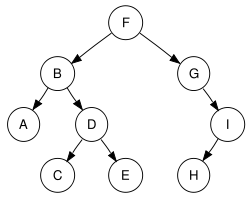A menu is a list of options from which the user makes a selection. Each option is a brief description for a selection (menu label) that can lead to a sub-menu or a specific action being performed.
The tree data structure is one of the most obvious structures used to represent menus. In trees information naturally forms a hierarchy - menu entries are naturally ordered above or below other entries. The tree data structure is a very efficient way to represent this type of information. Although a tree has built-in hierarchical structure, it can be stored as arrays of data.
Tree Structure Primer
This structure is named a tree structure because the classic representation resembles a tree, even though the chart is generally upside down compared to an actual tree, with the root at the top and the leaves at the bottom. The tree elements are called nodes. The lines connecting nodes are called branches. Nodes with no sub-nodes are called leaf nodes, end nodes, terminal nodes or leaves.

A tree is a special kind of graph that follows a particular set of rules and definitions:
- Connected - A graph can be a tree if it is connected. Each node is connected with a link to at least one other node.
- Acyclic - A graph can be a tree if is acyclic (ie, it has no cycles or loops in it). That means there's only one route from any node to any other node. This also means that a node may have many children but only one parent.
- Root - The term root commonly refers to a top-most node (ie, the one with no parent). In the figure above, node F is the root of the tree. The root is the starting for traversing any tree structure.
- Descendant - A descendant is a node that is farther away from the root than some other node. The term descendant is always referenced from another node. In the example, nodes I and H are descendants of node G.
- Parent - Parent is considered the node that is closer to the root node by one link or vertex, in the same branch. In the figure, node B is the parent of nodes A and D. The ultimate parent in a tree is the root node.
- Sibling - Sibling (brother or sister) nodes share the same parent. In the example, nodes A and D are siblings.
- Ancestor - An ancestor is any node between a given node and the root, including the root. In the figure, the ancestors of node H are nodes I, G, and F.
- Leaf or Terminal Node - A node is terminal if it has no children. In the example, node C is a leaf.
- Height or Depth - The height of a tree is defined as the number of vertices traversed to get to the most distant node. In the figure, the height of the tree is equal to three.


